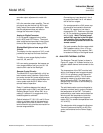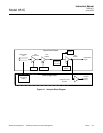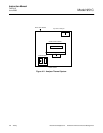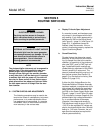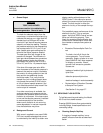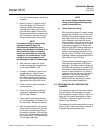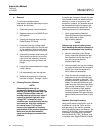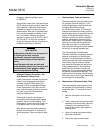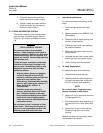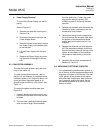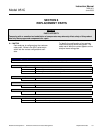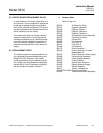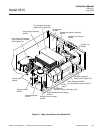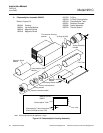
Instruction Manual
748214-V
June 2009
Rosemount Analytical Inc. A Division of Emerson Process Management Routine Servicing 5-5
Model 951C
Company under its catalog number
S-195650-A.
Using Alconox and clean, soft facial tissue
(NOT industrial wipes), carefully clean the
quartz window. Vigorously flush reaction
chamber and quartz window with clean
distilled water. Blow out all possible water
from internal passages of reaction cham-
ber. Dry reaction chamber and quartz
window in a warm oven at 125°F to 150°F
(52°C to 66°C) for 30 to 45 minutes or
purge-dry the parts with dry cylinder air or
nitrogen to eliminate all moisture.
WARNING
ACID HAZARD
Hydrochloric acid (HC1) is a strong acid. It
is irritating to the skin, mucous
membranes, eyes and respiratory tract.
Direct contact causes severe chemical
burns.
Avoid Contact with eyes and skin and
avoid breathing fumes. Use in hood or well
ventilated place. Wear goggles, rubber
gloves and protective clothing.
Alternate Cleaning Procedure - For
High Residual Fluorescence
Holding the reaction chamber by the tube
fittings, and using appropriate caution,
immerse the white Teflon part of the
chamber in 50% concentrated Reagent
Grade hydrochloric acid. After five min-
utes, rinse thoroughly with de-ionized wa-
ter, then air dry as in the standard
cleaning method above.
Place parts in position and press on
end-cap so that mating threads engage
properly, without cross threading. Turn
mating parts in one continuous motion un-
til the parts mesh. Do not over-torque.
With reaction chamber now assembled,
replace and reconnect it in reversed re-
moval sequence. Orient as noted in step
2.
c. Photomultiplier Tube and Housing
The photomultiplier tube operates at high
DC voltages (nominal setting is -1100
volts) and generates small currents that
are highly amplified by the sig-
nal-conditioning circuitry. It is therefore
important that ambient humidity and con-
densed water vapor be excluded from the
interior of the photomultiplier housing.
Ambient humidity can result in electrical
leakage, observed as abnormally high
dark current. Water vapor or condensed
moisture in contact with the photomulti-
plier tube may result in an abnormally
high noise level during instrument readout
on zero air or upscale standard gas.
The Photomultiplier Tube/Reaction
Chamber Assembly incorporates several
features for exclusion of humidity and
moisture. The photomultiplier socket as-
sembly is potted with high impedance sili-
cone rubber compound and is sealed
from external influences with epoxy and
rubber gasket material. The socket as-
sembly and the reaction chamber are
sealed with O-rings into opposite ends of
the tubular photomultiplier housing. The
socket end of the housing may be sealed
with either one or two O-rings, depending
on the length of the phototube.
d. Replacement of Photomultiplier Tube
The photomultiplier tube assembly must
be removed from the housing in order to
replace the tube. To remove, do the fol-
lowing:
1. Note the orientation of the connec-
tors.
2. Slowly rotate and withdraw the socket
assembly from the housing. Note the
orientation and placement of the
metal shield and the black plastic in-
sulating cover.
3. Carefully unplug the photomultiplier
tube from the socket.
4. Plug a new tube into the socket.



